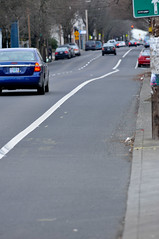When I first put forth the issue of cars parking in and completely blocking vehicle lanes reserved for bicycles (a.k.a. bike lanes), I didn’t expect to write two follow-ups about it. But I’ve gotten another interesting response from PBOT that is worth sharing.
Yesterday I shared a follow-up with a few insights gleaned from the helpful comments on the initial story as well as an explanation from PBOT about their enforcement policy.
At the end of yesterday’s story I wondered out loud whether or not more signage and markings from PBOT might be a good solution. Yesterday afternoon PBOT responded with an explanation of their engineering approach to the problem.
The 1996 Bike Master Plan called for bike lane pavement markings (the bike lane symbol) every 250 feet. That policy was amended in the 2030 Bike Plan to a bike lane symbol only being mandated every 1,000 feet — a cost-savings measure according to PBOT spokesperson Cheryl Kuck.
“While the 8-inch stripe is technically sufficient to enforce against parking in the bike lane, we know that some motorists don’t understand that and may be successful arguing their case with the court.”
— Cheryl Kuck, PBOT spokesperson
Kuck says PBOT expected that as a result of this new policy, there’d be locations where parking in the bicycle travel lane could become an issue. “While the 8-inch stripe is technically sufficient to enforce against parking in the bike lane,” Kuck wrote via email, “we know that some motorists don’t understand that and may be successful arguing their case with the court.” (Meaning, they’d get their tickets thrown out by the judge.)
In an effort to make this illegal parking stand up better in court (and thus make it more enforceable), Kuck says they decided to add additional markings and/or signage to specific locations when necessary.
Kuck described a collaboration between City Parking Enforcement officers, traffic engineers, and bicycle program staffers at PBOT. When officers see repeated violations at a particular location, they report it to PBOT, who then assesses if additional markings are needed.
Examples of locations where this tag-team effort has resulted in new markings include:
- NE Russell west of NE Rodney (near the Wonder Ballroom and Toro Bravo restaurant);
- NW 14th between NW Davis and NW Everett (to keep right-turning motorists out of the bike lane);
- SW Broadway in front of the Benson and the Heathman hotels (to prevent double-parking); and
- NE Rosa Parks Way (we’re currently investigating the need for markings in the bike lane near New Season’s Market).

Kuck says “No Parking” signage is not a preferred solution. Federal guidelines dictate that such signs must be placed every 100 feet — making their installation on an entire block-face cost-prohibitive. If PBOT only signs specific trouble spots (and not the entire lane), Kuck says they only, “confuse motorists and move the parking problem further down the bike lane outside the signed area.”
“Furthermore,” she adds, “we lose support from the Court, which cites inconsistency in the signage of bike lanes as a reason to toss out a citation related to illegal parking in a bike lane.”
So there you have it. We now have a better idea of the City’s role in addressing this problem. All things still lead back to the importance of citizen reporting. If you see cars parked and blocking a vehicle lane intended for bicycles, call (503) 823-5195 and let the City know about it. There’s a good chance your call will lead to tickets for offenders and it could even lead to more bike lane markings.


